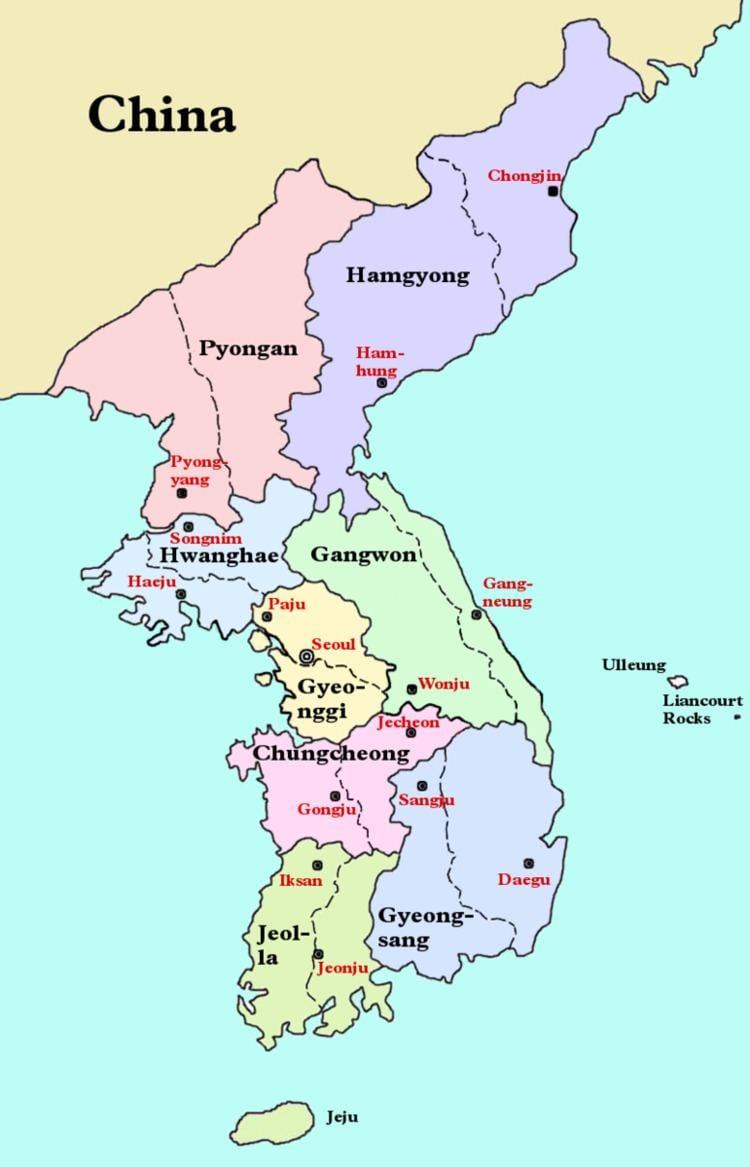Hangul 팔도 Revised Romanization Paldo | Hanja 八道 McCune–Reischauer P'alto | |
 | ||
During most of the Joseon Dynasty, Korea was divided into eight provinces (do; 도; 道). The eight provinces' boundaries remained unchanged for about 480 years from 1413 to 1895, and formed a geographic paradigm that is still reflected today in the Korean Peninsula's administrative divisions, dialects, and regional distinctions. The names of all eight provinces are still preserved today, in one form or another. These eight historical provinces form both North and South Korea, and are not to be confused with the current eight provinces that make up South Korea.
Contents
Provinces before 1895
In 1413 (the 13th year of the reign of King Taejong), the northeastern boundary of Korea was extended to the Tumen River. The country was reorganized into eight provinces: Chungcheong, Gangwon, Gyeonggi, Gyeongsang, Jeolla, P'unghae (renamed Hwanghae in 1417), P'yŏngan, and Yŏnggil (eventually renamed Hamgyŏng in 1509).
Districts of 1895-96
For almost 500 years, the eight-province system remained virtually unchanged. In 1895 (the 32nd year of the reign of King Gojong), the five-century-old provincial system was abolished. On May 26 of that year—as part of the Gabo Reform—the country was redivided into 23 districts, each named for the city or county that was its capital.
(Each district name in the following list links to the article on the province from which the district was formed, and where more detailed information on the district is provided):
Restored provinces of 1896
The new system of districts did not last long, however, as one year later, on August 4, 1896 (the 33rd year of King Gojong), the former eight provinces were restored, with five of them (Chungcheong, Gyeongsang, Jeolla, Hamgyŏng, and P'yŏngan), being divided into north and south halves, to form a total of 13 provinces. This structure remained unchanged through the entire lifetime of the Korean Empire (1897–1910) and the Japanese Colonial Period (1910–1945). Since the end of World War II and the division of Korea in 1945, special cities and administrative regions and a handful of new provinces have been added in both the South and North.
Cultural significance
The boundaries between the eight provinces for the most part followed rivers, mountain chains, and other natural boundaries, and consequently corresponded closely to dialect and cultural divisions. Because of this natural fit between the provincial boundaries and the "real world," most of the provincial boundaries and names have survived in one form or another down to today, and most Koreans are keenly aware of the regional and dialect distinctions that still exist.
For example, a famous regional rivalry (akin to, but somewhat more heated than, that between the American north and south) exists between Gyeongsang and Jeolla residents, sites of the ancient kingdoms of Silla and Baekje respectively, due to historic social, economic, and political differences, some of which have continued into the present day in more muted form. Most of the traditional provinces also had alternative regional names which are still used today (especially Honam, Yeongdong, and Yeongnam), at least in speech, if not on paper.
Modern-day usage
The term Paldo ("Eight Provinces") is itself often used as a shorthand to denote Korea as a whole, or to describe the traditional folk culture of Korea's regions. Thus, one sometimes finds such expressions as:
Cf. the four Provinces of Ireland—where reference to the ancient provinces is used to talk of the entire Irish island.
Names
With the exception of Gyeonggi (see note 2 below), each province took its name from the initial Hanja (Sino-Korean characters) of two of its principal cities. The origin of each province's name is detailed in the table below.
Table of provinces
The table below lists the eight provinces in romanized spelling, Hangul and Hanja; the origin of their names; their capitals, dialects, and regional names; and the 13 provinces that replaced them in 1896. (The capitals and regional names are as of the mid 19th century. Since they were not official, other regional names were also used, but the ones in the table are the most widely used or representative.)
